GASP! Gulf Area Sea Paddlers
WSRI trip report
Keith Hadland, hadlandk@lgwct.
logica.com, April 1995
This material is copyrighted by Mr. Hadland and reprinted here with
his permission
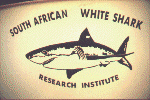 Finding a decent White Shark trip is a time consuming process. I started
looking in Spring of 93, and after chasing up many a blind alley it was
while staying with Brian Charles (skipper of JBC in Weymouth) that I got
my first good lead. His son was working in Australia and had just sent
back some video from a trip he worked on with Rodney Fox. I called him
in Australia and he gave me some cont acts to follow up, and eventually
I ended up calling Sea & Sea travel in San Francisco. "Sure, we do
a White Shark trip" they said. "Where, how long, how much" I asked.
"Dangerous Reef, Port Lincoln, Adelaide" was the where - sounds good,
"10 days living on board the Falie, a 100 foot yacht, with the crew
chumming 24 hours a day and enough cages for everybody" was the how
long - I was getting quite excited now. How much? "8000 US dollars per
person, once you get on the boat". Bugger.
Finding a decent White Shark trip is a time consuming process. I started
looking in Spring of 93, and after chasing up many a blind alley it was
while staying with Brian Charles (skipper of JBC in Weymouth) that I got
my first good lead. His son was working in Australia and had just sent
back some video from a trip he worked on with Rodney Fox. I called him
in Australia and he gave me some cont acts to follow up, and eventually
I ended up calling Sea & Sea travel in San Francisco. "Sure, we do
a White Shark trip" they said. "Where, how long, how much" I asked.
"Dangerous Reef, Port Lincoln, Adelaide" was the where - sounds good,
"10 days living on board the Falie, a 100 foot yacht, with the crew
chumming 24 hours a day and enough cages for everybody" was the how
long - I was getting quite excited now. How much? "8000 US dollars per
person, once you get on the boat". Bugger.
So, I decided to use this wonderful internet thing to see if I could
extract anything from the collective knowledge of the world's divers.
I posted a question on rec.scuba (well, when needs must...) and got a
few answers. One of these gave me a direct contact for the Falie's
owners. They told me that they only do the White Shark trips when
they're chartered by Rodney Fox, and gave me his fax number. So I
faxed Rodders, and Mrs Fox wrote back telling me that they only sell
places through Sea & Sea, but that they hadn't seen one shark in
their last 3 trips. That's 800 dollars per day to stare at the sea,
and we can sit off Portland and do it for free!
Back to rec.scuba... where I stumbled accross a South African chap
telling somebody about the sharks down there. A couple of e-mails
later and he'd done some investigating and come up with the number
for the White Shark Research Institute. Bingo! Yes, they would let
members go on expeditions - and it wasn't going to be indecently
expensive and there was a pretty darned good chance of spotting a
White Shark. Full speed ahead, Mr Sulu.
A few months later, it's 7.00am and I'm touching down at DF Malan
airport, Cape Town where I meet up with Jytte Ferreira of the WSRI.
Clambering into the back of the Range Rover (closely followed by
my luggage) I met Tomas, Marita and Charlotte (all Swedish) who were
the other members on this expedition. Now, having just got off a
10 hour flight I wasn't really in the right frame of mind to talk
about Abba and Volvos, so I found a 'comfortable' position and slept
for most of the 2 1/2 hour journey to Gaansbai.
We were staying in a large house with a fantastic view of a rocky
seashore - a good start. A quick change, and we were straight out to
clean the boat before we started pouring blood over the deck etc. This
is where we met the cage. Remember that cage in Jaws? The big square
one made of solid steel bars? 'Fraid not. Ours was a small, circular
cage - a steel framework covered with square mesh wire. But Craig
(the expedition leader) assured us it had been used dozens of times
and that it was safe. Well, time would tell.
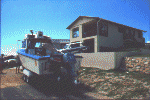 The afternoon was spent going through launching and recovery procedures
for the boat, an introductory talk about the White Shark, what to do if
a shark gets caught in the cage ropes, what to do if a shark pulls the
cage free of the boat and takes you on a ride, how to lean out of the
cage and undo the quick release on the ropes. All the time I was
remembering saying "Of course it's safe, don't worry".
The afternoon was spent going through launching and recovery procedures
for the boat, an introductory talk about the White Shark, what to do if
a shark gets caught in the cage ropes, what to do if a shark pulls the
cage free of the boat and takes you on a ride, how to lean out of the
cage and undo the quick release on the ropes. All the time I was
remembering saying "Of course it's safe, don't worry".
The first 'proper' day of the expedition and we all wake up at dawn.
Well, it would have been dawn but the thick fog sort of spoiled the
sunrise. Still, not a breath of wind, so we towed the boat down to the
harbour and prepared for lauch. Unfortunately, there's no such thing as
channel markers at Kleinbai (where we launched) or at Dyer Island, so we
had to sit and wait for the fog to clear.
About 2 hours later we were out at Dyer Island, moored in the channel,
with the sweet smell of 60,000 fur seals wafting over us and their gentle
calls playing on the breeze. Then we got our introduction to the bait.
Craig gets his baits from the Mammal Research department at Cape Town
University, and they get their seals from those that wash up dead
around the coast. The particular bait for that day was a part of a
large male seal. The front part- from the whiskers to the neck.
"Smiler", we called him. Now, how do you tie a seal head onto a rope?
Simple - there's a ready made hole, right through the middle.
Then we started chumming. Chum is made by emptying a bag of sardines
into a drum, then mashing them to bits with a large pole. Finally,
add about 1/2 litre of natural fish oil and top up with sea water.
Chumming is a full time job, because it's important to generate a
long, unbroken slick of scent which will attract the sharks. You
pour about 1/2 a scoop every 30 seconds, being careful not to pour
over any of the solids because they can be reused for the next batch.
So, there's one person chumming, one on lookout and the rest sunbathing,
sleeping or generally lounging around, with the odd interruption to
record environmental or oceanographic conditions. (Stefan, the WSRI's
oceanographer is trying to correlate water conditions with shark
behaviour). Every 30 mins or so, somebody else takes over the chumming
so everybody gets their share of the fun. It's a tough life out in
the field.
And that was how it stayed for the first day. Not a fin to be seen.
Seals happily frolicking in the surf without a care in the world. And
this is meant to be the place where sharks are prolific! Slightly
downhearted, we headed back to base, cleaned the boat, then went off
snorkelling to get some abalone for tea.
The second day began as early as the first, but this time there wasn't
any fog, so we were at Dyer Island by about 8.00. We got anchored and
prepared for the long wait, but 20 minutes later, Craig leapt to his
feet shouting 'Shark at the bait!'. A 3.8m female had come for a look
at Smiler. She did the classic approach - the first thing we saw was
the slight bulge on the glassy surface caused by her bow wave, then
two vortices formed signalling the arrival of the dorsal fin, which
rose through the surface heading straight for the bait. But she didn't
lunge for it in a frenzied attack - she just swam up slowly, almost
came to a stop next to the bait and then slowly turned and headed off
in another direction, swimming right past the stern of the boat.
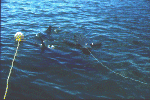 That was my first sight of a White Shark. Everybody knows that
they're large - but until you see one in the flesh, you don't
appreciate just how massive an animal they are. And nobody has told
you how graceful they are, how effortlessly they move, how calm they
are in their natural environment. As Charlotte said 'I just want to
get in there and hug it'.
That was my first sight of a White Shark. Everybody knows that
they're large - but until you see one in the flesh, you don't
appreciate just how massive an animal they are. And nobody has told
you how graceful they are, how effortlessly they move, how calm they
are in their natural environment. As Charlotte said 'I just want to
get in there and hug it'.
Our 3.8m visitor returned a couple of minutes later, and this time showed
a bit more interest in the bait. As she approached the bait, Stefan started
to pull the bait towards the boat, and Craig readied the tagging pole.
After another 2 or 3 approaches, she finally took the bait in her mouth and
Stefan started pulling her in.
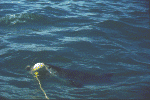 Things suddenly got very busy - Craig leaning over the side ready to insert
the tag, Stefan pulling the shark in right alongside the boat, directly
underneath where I was sitting with my camera. I have a vivid memory of
the shark's head completely clear of the water, with Smiler staring up at
me from its mouth.
Things suddenly got very busy - Craig leaning over the side ready to insert
the tag, Stefan pulling the shark in right alongside the boat, directly
underneath where I was sitting with my camera. I have a vivid memory of
the shark's head completely clear of the water, with Smiler staring up at
me from its mouth.
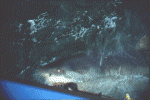 About 30 minutes later, the Natal Sharks Board turned up and anchored
down current from us. They were testing the electric barrier being
developed as a replacement for shark nets - as seen in the documentary
'Shark Shocker'. That day, we saw 4 other sharks at their boat, but
obviously the barrier was working because none of them came to take a
look at us. We did get one other shark - a 3m who w as way too frisky
to tag.
About 30 minutes later, the Natal Sharks Board turned up and anchored
down current from us. They were testing the electric barrier being
developed as a replacement for shark nets - as seen in the documentary
'Shark Shocker'. That day, we saw 4 other sharks at their boat, but
obviously the barrier was working because none of them came to take a
look at us. We did get one other shark - a 3m who w as way too frisky
to tag.
Back at base, we made plans for taking the cage out and starting to do
some underwater work. The WSRI have found that it's best to get 2 or 3
sharks around the boat before starting cage work - individual sharks
tend to be timid and generally don't stay around for very long.
We woke up the following morning to hear the wind howling - and down at
the harbour the fishermen had all stayed in. There was no way we were
going to Dyer Island, but research doesn't stop just because of that.
The WSRI had heard of a seal colony at Quoin Point about 50km south
along the coast. There were reports of White Shark sightings there,
so we headed off to determine if this was a viable research site. It's
not an easy place to reach, requiring some major off-roading in the
Range Rover and a 3km walk, but eventually we reached Quoin Point. The
seal colony is on an island which is no more than 200 yards offshore - it
would be quite feasible to sit on the hills with a pair of binoculars and
keep a record of shark activity as it happens. Local fishermen had told
us that they had seen White Sharks swimming through the kelp to attack seals.
The next day was almost as rough - but we managed to launch from Gaansbai,
where the largest White Shark on record in South Africa was caught.
Gaansbai isn't recognised as a popular shark hangout, and we had a shark
free day.
The weather was still giving us a hard time the next day - but as the day
wore on, the wind eased and we managed to launch about 11.00. Out to Dyer
Island, and by now we were desperate to get some shark work done. We'd
had to say farewell to Smiler, so we had a new bait which is best described
as a seal version of a Polo - take a frozen dead seal, chop the middle
third out and you've got a donut of seal meat with all the sloppy bits
in the middle.
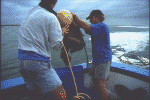 The bait went over the side, and in minutes we had our first visitor, a
small shark with a big appetite. This guy took about 1/2 of our brand
new bait, and we couldn't even tag it. Within 15 minutes we had our next
visitor - a 4m male. This was a serious lump of fish. Then Craig said
those magic words... 'Who wants to go in the cage'. Well, before he'd
finished speaking I was half kitted. No fins and 2 weightbelts, then a
short step over the side of the boat and into the cage - making sure you
get through the gap in the top!
The bait went over the side, and in minutes we had our first visitor, a
small shark with a big appetite. This guy took about 1/2 of our brand
new bait, and we couldn't even tag it. Within 15 minutes we had our next
visitor - a 4m male. This was a serious lump of fish. Then Craig said
those magic words... 'Who wants to go in the cage'. Well, before he'd
finished speaking I was half kitted. No fins and 2 weightbelts, then a
short step over the side of the boat and into the cage - making sure you
get through the gap in the top!
The water was quite choppy, so the cage was moving around and I was getting
thrown around inside it. So you sink to the bottom of the cage, brace
yourself so you don't get hit by the cage, then the motion could easily
make you horribly seasick. Viz wasn't too good, down to about 3m so all
I could see was the bait and the back of the boat. At first I was really
jumpy, thinking that every jolt on the cage was our 4m friend come back to
see me. After a while, I settled down to wait for that shape to appear,
then after a bit longer I started to get bored and cold. Then the anchor
on the boat came loose and we started drifting toward the rocks, so my
dive had to be aborted.
Things got kinda busy after that - I got back on the boat, then we tried
to re-anchor, but the weather was worsening rapidly, so we headed back to
base.
The next few days were also windy & rough, but we managed to get out
to Dyer Island each day, working with the sharks as and when they appeared.
We had one resighting of a tagged shark, but the sharks were still turning
up individually and not staying around, so it wasn't worth trying the cage.
On one day we'd been shark free for about 5 hours, and were starting to
talk about swimming to the bait & back - just as we were lifting the
anchor there was a huge splash dead ahead, then a dorsal fin appeared and
thrashed for a couple of seconds. Another seal bites the dust. Just
because the sharks don't come to the boat doesn't mean they're not there.
On the last day we headed out to Struisbaai to check out the activity there.
It took almost 2 hours to get our first shark, but we then got another 2 in
quick succession and the cage went into the water. Marita, one of the Swedish
girls, was first into the cage - she said that the viz was terrible (we
couldn't see the bottom of the cage from the surface), and despite a few
close passes she didn't get a good look at a shark from the cage. Once
again the wind had been picking up during the morning and conditions were
getting dodgy, but when Marita came out of the cage, Tomas went in. Tomas
lasted about 5 minutes before the seasickness got too bad and Tomas popped
up and was somewhat poorly, just as Marita was hanging over the side of the
boat. What the heck, it's all chum. The weather wasn't getting any better,
so we called it a day and went back.
We were unlucky during our trip - the weather at that time of year is normally
fairly settled, and although we saw 10 individuals up close during our
expedition, that was a relatively low number. It shows just what a rare and
unpredictable animal the White Shark is - and why it is so important that we
don't allow our prejudice to destroy the most effective predator there is.
I'm determined to see these animals up close - maybe next time I'll get my
face to face meeting with a 4m shark (with a cage in the way). Until then
I'll look forward to receiving my WSRI newsletters - if you're concerned
with the fate of dolphins and whales, shouldn't you protect the sharks as
well?
 Back to GASP's home page
Back to GASP's home page
 The afternoon was spent going through launching and recovery procedures
for the boat, an introductory talk about the White Shark, what to do if
a shark gets caught in the cage ropes, what to do if a shark pulls the
cage free of the boat and takes you on a ride, how to lean out of the
cage and undo the quick release on the ropes. All the time I was
remembering saying "Of course it's safe, don't worry".
The afternoon was spent going through launching and recovery procedures
for the boat, an introductory talk about the White Shark, what to do if
a shark gets caught in the cage ropes, what to do if a shark pulls the
cage free of the boat and takes you on a ride, how to lean out of the
cage and undo the quick release on the ropes. All the time I was
remembering saying "Of course it's safe, don't worry".
 Finding a decent White Shark trip is a time consuming process. I started
looking in Spring of 93, and after chasing up many a blind alley it was
while staying with Brian Charles (skipper of JBC in Weymouth) that I got
my first good lead. His son was working in Australia and had just sent
back some video from a trip he worked on with Rodney Fox. I called him
in Australia and he gave me some cont acts to follow up, and eventually
I ended up calling Sea & Sea travel in San Francisco. "Sure, we do
a White Shark trip" they said. "Where, how long, how much" I asked.
"Dangerous Reef, Port Lincoln, Adelaide" was the where - sounds good,
"10 days living on board the Falie, a 100 foot yacht, with the crew
chumming 24 hours a day and enough cages for everybody" was the how
long - I was getting quite excited now. How much? "8000 US dollars per
person, once you get on the boat". Bugger.
Finding a decent White Shark trip is a time consuming process. I started
looking in Spring of 93, and after chasing up many a blind alley it was
while staying with Brian Charles (skipper of JBC in Weymouth) that I got
my first good lead. His son was working in Australia and had just sent
back some video from a trip he worked on with Rodney Fox. I called him
in Australia and he gave me some cont acts to follow up, and eventually
I ended up calling Sea & Sea travel in San Francisco. "Sure, we do
a White Shark trip" they said. "Where, how long, how much" I asked.
"Dangerous Reef, Port Lincoln, Adelaide" was the where - sounds good,
"10 days living on board the Falie, a 100 foot yacht, with the crew
chumming 24 hours a day and enough cages for everybody" was the how
long - I was getting quite excited now. How much? "8000 US dollars per
person, once you get on the boat". Bugger.




